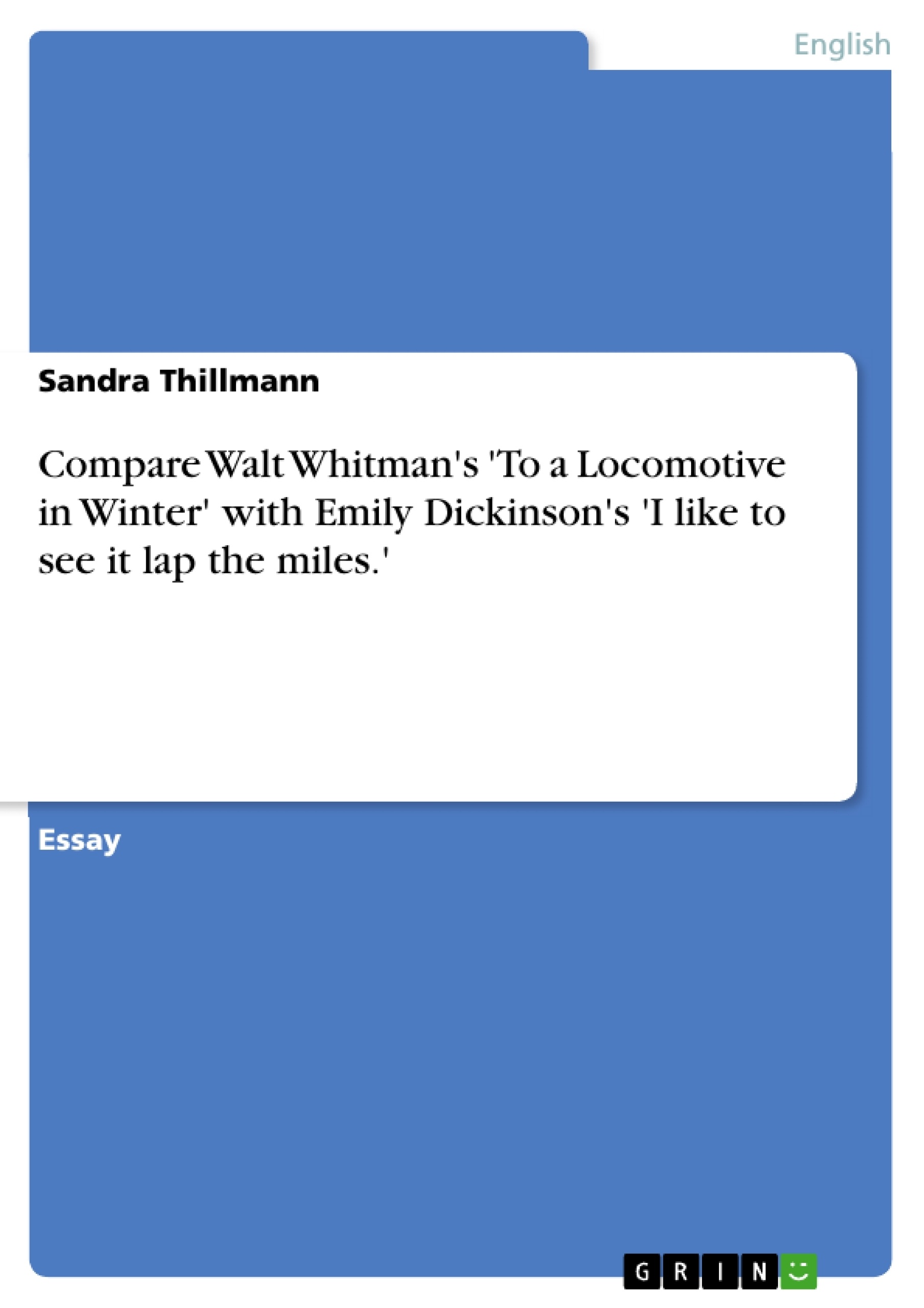“To a Locomotive in Winter”, written by Walt Whitman, is about a locomotive, that is described as very strong and powerful in a positive way. In the poem it becomes clear that the speaker is a supporter of the technological progress of America, represented by the locomotive, because he tries to establish a connection between poetry and science. Emily Dickinson’s “I like to see it lap the Miles” is also about a locomotive. Again poetry and science are linked in a certain way but in contrast to Whitman her poem has some negative connotations. So maybe the speaker is no supporter of America’s technological progress or at least he is afraid of the future fortune.
Table of Contents
- Poetry Analysis
Objectives and Key Themes
This analysis compares Walt Whitman's "To a Locomotive in Winter" and Emily Dickinson's "I like to see it lap the Miles," focusing on how each poem portrays the relationship between poetry, science, and technological progress in 19th-century America. The analysis explores the speakers' perspectives on the impact of the railroad and industrialization.
- Comparison of poetic styles and structures
- Contrasting perspectives on technological progress
- The use of imagery and symbolism in each poem
- The relationship between poetry and science
- Analysis of the speakers' voices and attitudes
Chapter Summaries
Poetry Analysis: This chapter provides a comparative analysis of Walt Whitman's "To a Locomotive in Winter" and Emily Dickinson's "I like to see it lap the Miles," focusing on their contrasting portrayals of the relationship between poetry, science, and technological progress. Whitman's poem celebrates the locomotive as a symbol of American technological advancement, employing a dynamic, energetic style and positive imagery to express his admiration. The speaker directly addresses the locomotive, creating a sense of awe and wonder. Conversely, Dickinson's poem presents a more ambivalent and perhaps critical view. While the poem initially seems appreciative, a closer examination reveals potentially negative connotations associated with the rapid, almost overwhelming, pace of technological advancement. The use of animal imagery, paradoxical statements, and a less celebratory tone suggests a different interpretation of the impact of the railroad and industrialization. The analysis delves into the stylistic choices, such as the use of anaphora, free verse, and specific word choices, to demonstrate how each poet conveys their unique perspective.
Keywords
Walt Whitman, Emily Dickinson, "To a Locomotive in Winter," "I like to see it lap the Miles," American literature, 19th-century poetry, technological progress, industrialization, imagery, symbolism, poetic style, comparative analysis, science, poetry.
Frequently Asked Questions: Analysis of Whitman's "To a Locomotive in Winter" and Dickinson's "I like to see it lap the Miles"
What is the main focus of this analysis?
This analysis compares and contrasts Walt Whitman's "To a Locomotive in Winter" and Emily Dickinson's "I like to see it lap the Miles," examining how each poem portrays the relationship between poetry, science, and technological progress in 19th-century America. It explores the speakers' different perspectives on the impact of the railroad and industrialization.
What poems are being analyzed?
The analysis focuses on two poems: Walt Whitman's "To a Locomotive in Winter" and Emily Dickinson's "I like to see it lap the Miles."
What are the key themes explored in the analysis?
Key themes include a comparison of poetic styles and structures, contrasting perspectives on technological progress, the use of imagery and symbolism in each poem, the relationship between poetry and science, and an analysis of the speakers' voices and attitudes.
How does Whitman portray the locomotive in his poem?
Whitman's poem celebrates the locomotive as a symbol of American technological advancement. He uses a dynamic, energetic style and positive imagery to express his admiration, directly addressing the locomotive with a sense of awe and wonder.
How does Dickinson portray the train in her poem?
Dickinson's poem presents a more ambivalent and potentially critical view of the train and technological advancement. While initially appearing appreciative, closer examination reveals potentially negative connotations associated with the rapid pace of progress. The use of animal imagery, paradoxical statements, and a less celebratory tone suggests a different interpretation of the impact of the railroad and industrialization.
What stylistic elements are analyzed in the poems?
The analysis delves into the stylistic choices of both poets, including the use of anaphora, free verse, and specific word choices, to demonstrate how each conveys their unique perspective on technology and its impact.
What are the key words associated with this analysis?
Key words include: Walt Whitman, Emily Dickinson, "To a Locomotive in Winter," "I like to see it lap the Miles," American literature, 19th-century poetry, technological progress, industrialization, imagery, symbolism, poetic style, comparative analysis, science, poetry.
What is included in the provided text?
The provided text is a comprehensive preview including the title, table of contents, objectives and key themes, chapter summaries, and keywords.
- Arbeit zitieren
- Sandra Thillmann (Autor:in), 2006, Compare Walt Whitman's 'To a Locomotive in Winter' with Emily Dickinson's 'I like to see it lap the miles.', München, GRIN Verlag, https://www.grin.com/document/71094



